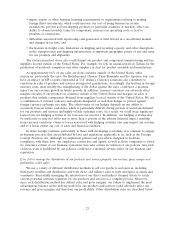HP 2009 Annual Report Download - page 27
Download and view the complete annual report
Please find page 27 of the 2009 HP annual report below. You can navigate through the pages in the report by either clicking on the pages listed below, or by using the keyword search tool below to find specific information within the annual report.or manufacture, including ‘‘bugs’’ and other problems that could unexpectedly interfere with the
operation of the system. The costs to us to eliminate or alleviate security problems, bugs, viruses,
worms, malicious software programs and security vulnerabilities could be significant, and the efforts to
address these problems could result in interruptions, delays, cessation of service and loss of existing or
potential customers that may impede our sales, manufacturing, distribution or other critical functions.
We manage and store various proprietary information and sensitive or confidential data relating to
our business. In addition, our outsourcing services business routinely processes, stores and transmits
large amounts of data for our clients, including sensitive and personally identifiable information.
Breaches of our security measures or the accidental loss, inadvertent disclosure or unapproved
dissemination of proprietary information or sensitive or confidential data about us or our clients,
including the potential loss or disclosure of such information or data as a result of fraud, trickery or
other forms of deception, could expose us, our customers or the individuals affected to a risk of loss or
misuse of this information, result in litigation and potential liability for us, damage our brand and
reputation or otherwise harm our business. We also could lose existing or potential customers for
outsourcing services or other information technology solutions or incur significant expenses in
connection with our customers’ system failures or any actual or perceived security vulnerabilities in our
products. In addition, the cost and operational consequences of implementing further data protection
measures could be significant.
Portions of our IT infrastructure also may experience interruptions, delays or cessations of service
or produce errors in connection with systems integration or migration work that takes place from time
to time. We may not be successful in implementing new systems and transitioning data which could
cause business disruptions and be more expensive, time consuming, disruptive and resource-intensive.
Such disruptions could adversely impact our ability to fulfill orders and interrupt other processes.
Delayed sales, lower margins or lost customers resulting from these disruptions have adversely affected
in the past, and in the future could adversely affect, our financial results, stock price and reputation.
The revenue and profitability of our operations have historically varied, which makes our future financial
results less predictable.
Our revenue, gross margin and profit vary among our products and services, customer groups and
geographic markets and therefore will likely be different in future periods than our current results. Our
revenue depends on the overall demand for our products and services. Delays or reductions in IT
spending could materially adversely affect demand for our products and services, which could result in
a significant decline in revenues. Overall gross margins and profitability in any given period are
dependent partially on the product, customer and geographic mix reflected in that period’s net revenue.
In particular, IPG and certain of its business units such as printer supplies contribute significantly to
our gross margin and profitability. In addition, our services business has contributed significantly to our
revenue and operating profit in recent periods. Competition, lawsuits, investigations and other risks
affecting those businesses therefore may have a significant impact on our overall gross margin and
profitability. Certain segments, and ESS in particular, have a higher fixed cost structure and more
variation in gross margins across their business units and product portfolios than others and may
therefore experience significant operating profit volatility on a quarterly basis. In addition, newer
geographic markets may be relatively less profitable due to investments associated with entering those
markets and local pricing pressures, and we may have difficulty establishing and maintaining the
operating infrastructure necessary to support the high growth rate associated with some of those
markets. Market trends, competitive pressures, commoditization of products, seasonal rebates, increased
component or shipping costs, regulatory impacts and other factors may result in reductions in revenue
or pressure on gross margins of certain segments in a given period, which may necessitate adjustments
to our operations.
20
























